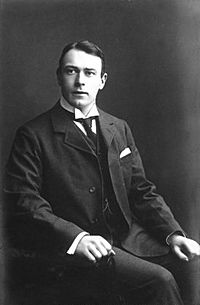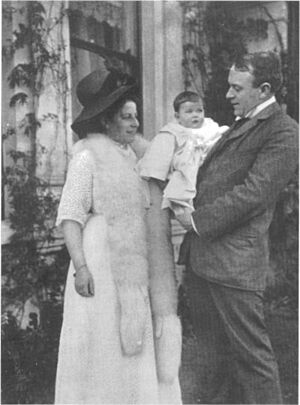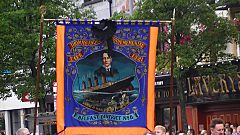Thomas Andrews facts for kids
Quick facts for kids
Thomas Andrews
|
|
|---|---|

Andrews in 1911
|
|
| Born |
Thomas Andrews Jr.
7 February 1873 Comber, County Down, Ireland
|
| Died | 15 April 1912 (aged 39) |
| Nationality | British |
| Occupation | Shipbuilder |
| Known for | Chief Designer of RMS Titanic |
| Spouse(s) |
Helen Reilly Barbour
(m. 1908) |
| Children | 1 |
| Relatives | Viscount Pirrie (uncle) J. M. Andrews (brother) |
Thomas Andrews Jr. (born February 7, 1873 – died April 15, 1912) was a British businessman and shipbuilder. He was a top manager and head of the design team at Harland and Wolff, a shipbuilding company in Belfast, Northern Ireland.
Andrews was the main naval architect who designed the famous ocean liner Titanic. He died along with over 1,500 other people when the ship sank on its first trip.
Contents
Early Life and Education
Thomas Andrews was born on February 7, 1873, in Comber, Ireland. His parents were Thomas Andrews and Eliza Pirrie. Thomas was from a Scottish family and considered himself British.
He had two brothers, J. M. Andrews and Sir James Andrews. In 1884, Thomas started school at the Royal Belfast Academical Institution. When he was 16, in 1889, he began an apprenticeship at Harland and Wolff. His uncle, Viscount Pirrie, was a part-owner of the company.
Working at Harland and Wolff
Thomas Andrews spent five years learning about shipbuilding at Harland and Wolff. He worked in different areas, like the joiners' shop and the cabinetmakers' shop. The last year and a half of his training was spent in the drawing office, where ships are designed. He worked during the day and studied in the evenings.
By 1901, after working in many parts of the company, he became the manager of construction. In 1907, he was made the managing director and head of the design department. Andrews was known as a very smart person in ship design. People at the company liked him because he was kind and fair. He always gave credit to others for their hard work.
On June 24, 1908, Thomas married Helen Reilly Barbour. Their daughter, Elizabeth Law-Barbour Andrews, was born on November 27, 1910. Thomas even took Helen to see the Titanic one night before their daughter was born.
Designing the RMS Titanic
In 1907, Andrews started to plan three new ocean liners for the White Star Line. These were the RMS Olympic, the RMS Titanic, and the Britannic. Andrews, William Pirrie, and Alexander Carlisle designed these ships to be the biggest, safest, and most luxurious at sea.
Andrews knew every detail of these ships. He wanted to make sure they worked perfectly. He suggested that the Titanic should have 48 lifeboats, but it only carried 20. He also suggested a double hull (an extra layer of protection) and watertight walls that went higher up in the ship. These ideas were not fully used.
Andrews led a group of Harland and Wolff workers called the "guarantee group." They traveled on the first trips of new ships to check how they worked and find any needed improvements. Andrews and his group traveled on the Titanic from Belfast to Southampton for its first voyage on April 10, 1912. During the trip, Andrews made notes about small changes he thought were needed. On April 14, he told a friend that the Titanic was "as nearly perfect as human brains can make her."
The Sinking of the Titanic
On April 14, 1912, at 11:40 PM, the Titanic hit an iceberg. Andrews was in his cabin and barely noticed the collision. Captain Edward J. Smith called Andrews to help check the damage.
Andrews and Captain Smith looked at the damaged part of the ship. Andrews quickly realized that five of the ship's sixteen watertight compartments were filling with water. The ship was designed to stay afloat with only four compartments flooded. He told Captain Smith that the ship had only about an hour left before it would sink. He also told the Captain that there were not enough lifeboats for everyone on board.
As people started to leave the ship, Andrews worked tirelessly. He went to staterooms and told passengers to put on lifebelts and go to the deck. Many people who survived said they saw Andrews helping others. He knew there was not enough space in the lifeboats for everyone. He kept urging people to get into the lifeboats to save as many lives as possible.
The Titanic sank at 2:20 AM on April 15, 1912. Thomas Andrews died with more than 1,500 other people. His body was never found.
Andrews' Last Moments
A steward named John Stewart said he saw Andrews around 2:05 AM. Andrews was standing alone in the first-class smoking room. His arms were crossed, and his lifebelt was on a table nearby. Stewart asked him if he was going to try to escape, but Andrews did not answer. Some believe he was in shock.
Another story says that Andrews was seen helping people even later. He was seen on the back of the boat deck, throwing deck chairs into the ocean for people to use as flotation devices. He was also seen carrying a lifebelt, possibly heading towards the ship's bridge. One steward claimed to have seen Andrews and Captain Smith together on the bridge just before the ship sank completely. Both men reportedly jumped overboard as the bridge went under water.
Thomas Andrews' Legacy
On April 19, 1912, Thomas Andrews' father received a telegram. It said that Titanic officers agreed Andrews "died a heroic death, thinking only of other's safety."
Newspapers called Andrews a hero. Mary Sloan, a stewardess he helped get into a lifeboat, wrote that "Mr. Andrews met his fate like a true hero... and gave up his life to save the women and children of the Titanic."
A special memorial hall was built in his hometown of Comber in January 1914. It is called the Thomas Andrews Jr. Memorial Hall. Today, it is used by The Andrews Memorial Primary School. There is also a blue plaque on his house in Belfast.
The SS Nomadic is the only ship designed by Andrews that still exists today. An asteroid, 245158 Thomasandrews, was named in his honor in 2004.
Portrayals in Media
- Patrick Macnee (1956; Kraft Television Theatre; A Night to Remember)
- Michael Goodliffe (1958; A Night to Remember)
- Geoffrey Whitehead (1979; S.O.S. Titanic; TV Movie)
- Victor Garber (1997; Titanic)
- Michael Cerveris (1997; Titanic; Broadway Musical)
- Vern Urich (1998; Titanic: Secrets Revealed; TV Documentary)
- Don Lynch (2003; Ghosts of the Abyss; Documentary)
- Damian O'Hare (2005; Titanic: Birth of a Legend; TV Documentary)
- Paul Mundell (2011; Curiosity Episode: "What Sank Titanic?")
- Stephen Campbell Moore (2012; Titanic; TV series/3 episodes)
- Billy Carter (2012; Titanic: Blood and Steel; TV series/12 episodes)
- Nick Danan (2012; The Titanic Boys; Stage Production- Grand Opera House, Belfast)
- Stephen Hogan (2012; Saving The Titanic; PBS TV Movie)
- Robert Bagdon (2013; Belfast Air; Short Film)
- Greg Castiglioni (2013; Titanic (musical) (London premier) & 2015; (Toronto); directed by Thom Southerland)
- Kazuki Kato (2015; Titanic; Japanese Musical; directed by Thom Sutherland)
See also
 In Spanish: Thomas Andrews para niños
In Spanish: Thomas Andrews para niños




